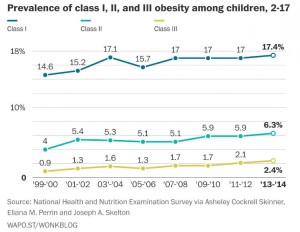By Adam Becker, PhD, MPH, Executive Director, and Maryann Mason, PhD, Community and Evaluation Research Director, Consortium to Lower Obesity in Chicago Children
Current trends in childhood obesity have been in the news lately. In 2014, the CDC issued a report, based on research from its National Center for Health Statistics, concluding that obesity prevalence was leveling off for most kids and even declining for the youngest age group. You may have heard people saying that obesity rates had plateaued. A number of cities and communities were highlighted as having downward trends in childhood obesity and it was assumed that these local trends were contributing to the plateau at the national level. Here in Chicago, CLOCC reported a downward trend from 2003-2004 to 2009-2010 among children entering school. Chicago Public School data from 2011-2012 and 2013-14, analyzed and published by CDPH, has confirmed the slight, but significant, downward trend.
However, this April, an  article appeared in the journal Obesity stating that previously-documented downward national trends were overstated and that “there is no evidence of a decline in obesity prevalence in any age group, despite substantial clinical and policy efforts targeting the issue.” So, what to make of this discrepancy? It goes back to the length of time referenced in the comparisons. When we look at obesity rates over time, the longer time frame we examine, the more the trend comes in to focus. As pointed out in a recent Washington Post article “when you start earlier, the narrative changes considerably.” Longer time periods help us put variations into perspective. For example, the more years of data we have, the easier it is to spot outliers – rates that are significantly higher or lower than years before and after them.
article appeared in the journal Obesity stating that previously-documented downward national trends were overstated and that “there is no evidence of a decline in obesity prevalence in any age group, despite substantial clinical and policy efforts targeting the issue.” So, what to make of this discrepancy? It goes back to the length of time referenced in the comparisons. When we look at obesity rates over time, the longer time frame we examine, the more the trend comes in to focus. As pointed out in a recent Washington Post article “when you start earlier, the narrative changes considerably.” Longer time periods help us put variations into perspective. For example, the more years of data we have, the easier it is to spot outliers – rates that are significantly higher or lower than years before and after them.
CLOCC’s findings of a downward trend were based on five-year’s worth of data. This gives us reason for cautious optimism. The more recent CPS/CDPH prevalence reports took a year-by-year look at rates. We are a bit more cautious in interpreting these findings.
So, what does this most recent finding of no significant decline in childhood obesity at the national level mean for our work locally and nationally? These data indicate that we are in a period of fluctuation where year-to-year, the obesity rates may rise or may fall. This follows a three-decade period where the rate consistently rose. So, this disruption in consistent increases is good news in the sense that the upward trend has been interrupted with intervals where the rates may be declining. But the longer the timeframe, the more clear the picture is painted in terms of the overall trend. Taking the longer view, it appears that, nationally, the downward trends reported may not be enduring. What’s further, there has been much evidence to suggest that disparities in childhood obesity and increases in the numbers of children who are severely obese persist.
We have work to do as a nation to combat this epidemic. Locally, we don’t yet have the ability to look at long-term trends, but as CPS and CDPH continue to analyze and publish childhood obesity data, we may soon be able to create a broad view of long-term trends. Until that point, we must continue to work hard to ensure that children, their families and communities have the resources, access, knowledge, and support they need to eat healthy and be physically active where they live, learn and play. National fluctuations and local indications that rates may be leveling off or coming down should encourage us to aggressively use the evidence base in efforts to improve environments and services, increase resources devoted to obesity prevention and to continue the education and support of children and families. Following that course, we endeavor to establish a downward trend in all children that will hold over the longer term.

